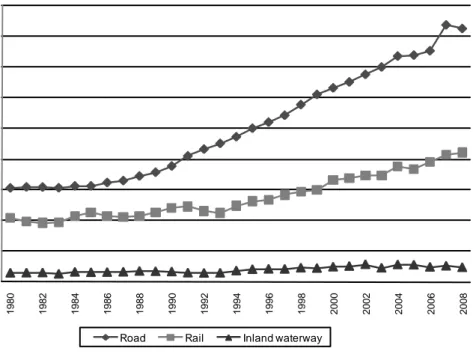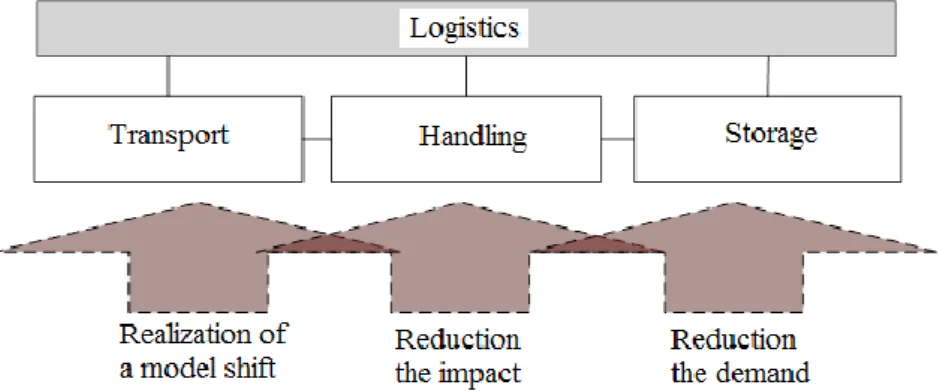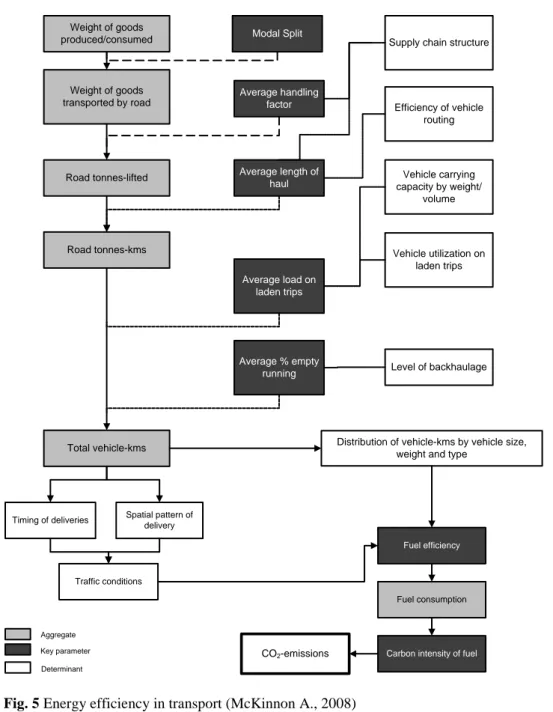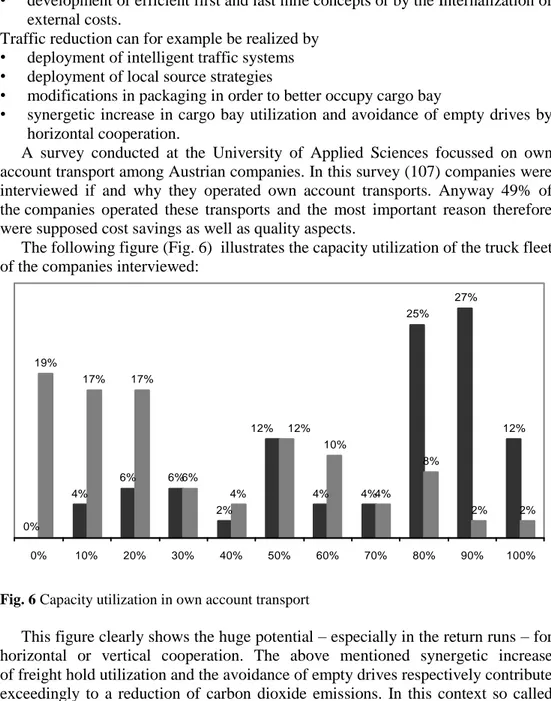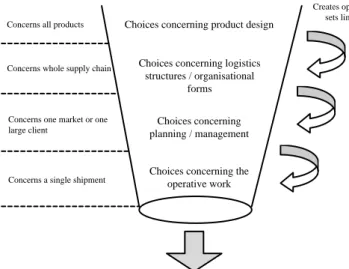ENERGY EFFICIENCY IN LOGISTICS
Doris Humpl*
* FH OÖ Forschungs & Entwicklungs GmbH, Logistikum.research, Wehrgrabengasse 1-3, 4400 Steyr, Austria, Email: doris.humpl@fh-steyr.at
Abstract The paper contributed describes potentials for enhancing energy efficiency in logistics.
Modern logistics management is able to increase transport efficiency by means of innovative concepts. Measures for enhancing energy efficiency in logistics range from political governance to technical approaches throughout the whole logistics chain. Various options will be discussed and a future outlook will be given.
Paper type: Research Paper Published online: 21 April 2011
© 2011 Poznan University of Technology. All rights reserved.
Keywords: Logistics, Energy Efficiency, Storage, Handling, Transport
1. GENERAL CONDITIONS
In January 2008 the European Commission has brought forward a package of measures which is frequently entitled as 20-20-20-goals. The correspondent proposals focus on a restrictive climate and energy policy and define new goals. Until 2020 20% less emission of greenhouse gases, 20% portion of renewable energy and 20% more energy efficiency will have to be effective. Concerning the reduction of greenhouse gases, so-called burden sharing, a load distribution among EU member states will take place. Austria for example is bound to reduce
its emissions by 16% in comparison to 2005. This target value is effective for all emitters that are not included in the DC 2003/87/EG. The emission trading systems shall be enforced and used more restrictive. Certificates will be no longer distributed at any charge and areas, included in the emission trading system will be assigned a reduction target of 21%. Another fundamental component of the climate policy is a draft directive for carbon dioxide storage. In the wake of this draft directive technologies and practical application areas of geological carbon dioxide storage have to be enforced. The third important cornerstone is the enforcement of renewable energies. Their portion of the overall energy consumption, which means in the consumption of electricity, heat and fuel, has to increase up to 20% (http://www.e-control.at/.../20-20-20-ziele).
Within the scope of the Kyoto protocol Austria has committed itself to reduce its greenhouse gas emission until 2012 to an average of 68.8 million tons. One major problem in this context is traffic, which shows an increase in emissions by 73% since 1990 and is 5.7 million tons above the goals of the Austrian climate strategy (http://diepresse.com/.../443123/index.do?direct=443126&_vl_back). The sector traffic accounts for a quarter of the overall emissions (http://www.exaa.at/.../9860080).
Fig. 1 Traffic carriers in Austria (Federal Ministry for Transport, Innovation
and Technology, 2009) 0 5.000 10.000 15.000 20.000 25.000 30.000 35.000 40.000 45.000 1980 1982 1984 1986 1988 1990 1992 1994 1996 1998 2000 2002 2004 2006 2008 M il li o n to n n e ki lo m e tre s
The first part of this text focuses on freight traffic in the context of potentials to enhance energy efficiency. The following figure illustrates the traffic performance in freight transport in the period 1980 to 2008. It becomes apparent that the traffic carrier road records the highest rates of growth concerning traffic performance during the last 28 years.
A comparable trend can be seen in the EU-27. Road transport not only dominates concerning traffic performance but shows a disproportionately high percentage of 72% in carbon dioxide emissions in the transport sector. Main determinant therefore is the high and still increasing portion of trucks. A shift to alternative modes of transport could contribute considerably to an increase in energy efficiency (European Commission, 2007, p. 186). In this context energy efficiency means to get a desired benefit (products or services) with minor energy input or to get as much benefit as possible from a certain energy input.
2. PROBLEMS AND BASIC CONDITIONS
The amount of freight traffic is dependent on various factors. Globalization changes production, procurement and marketing processes alike. Production processes are no longer set up on national levels but rather in a global environment. Freight traffic is therefore associated with a wide range of determinants (Aberle G., 2003): • level and structure of production and commercial activities in a national
economy
• density of economic activities in an area • intensity and structure of foreign trade • large-scale position of a national economy
• characteristics of freight logistics within the producing and trading economy • quantity and quality of the transport network
• level and structure of transport fees et cetera.
In a macro-economic view the efficiency of transport systems as well as the efficiency of a national economy depicts a reciprocal relation. Both transportation and shipping are fundamental prerequisites for the adequate satisfaction of goods demand, a higher division of labour and more competition. This is valid for the domestic market as well as for foreign trade. Economic prosperity increases the demand for freight traffic inversely (Schieck A., 2008).
Modern logistics management is able to increase transport efficiency by means of innovative concepts. Nevertheless, short periodic and low-inventory economic processes are responsible for a fast growth of freight traffic and are the reason for the affinity towards road haulage, which is responsible for the dependency on fossil fuels. As long as the supply with these fuels seems to be secured, transport and logistics will be organized in the same way, ignoring the alarming dependence. In addition people in charge at the transport policy operate as if fuel were
at unrestricted disposal and available at moderate prizes. The construction of traffic infrastructure and the elimination of traffic bottlenecks seem to be the only agenda. A paradigm shift is inevitable, especially in the face of the aspired reduction in carbon dioxide emissions by 2020.
Besides energy supply, nutrition and farming as well as building and living transport is one of the major scopes of action, in which the propagated sustainable development has to be realized (Grunwald A. and Kopfmüller J., 2006). Basic measures for an adequate impact on the traffic system can be outlined as follows: • realization of a modal shift
• reducing the demand for transport • reducing the impact of transport.
Traffic systems have to meet the social, economic and ecological requirements while avoiding any negative impacts on the economy, society or environment. These goals lead to operative measures such as the decoupling of economic growth and transportation demand with the purpose to minimize the impact on the environment. Therefore the following measures have to be taken:
• Extension of the Trans-European Network in the intermodal integration for freight logistics as an alternative for road transportation.
• Levy of infrastructure tariff rates for all modes of transport. The EU commission is issuing a transparent, common applicable model for the assessment of external costs, which should be the basis for prospective calculations of infrastructure tariff rates.
• Enhancement of the road infrastructure and safety of vehicles.
• Elaboration of a long-term and coherent EU-wide fuel strategy (Halbritter G., Fleischer T. and Kupsch C., 2008).
A multi-dimensional view on policy shows, that the deployment of alternative energy cannot be the only solution. Traffic and logistics offer a variety of potentials, which will be outlined in the paper at hand.
Ecological strategies allow for fulfilling environmental needs and careful use of fossil fuels while generating long-term market advantages. According a study of Accenture, the declaration of carbon dioxide emitted during manufacturing, logistics and packaging is an important criterion for 70% of the German population (Michalek P., 2009).
This fact once again outlines the increasing importance of logistics as an influencing value in the context of contributing to a company’s success and fulfilling ecological demands of stakeholders.
3. TRANSPORT – TRAFFIC – LOGISTICS
Logistics is the part of the supply chain process that plans, implements, and controls the efficient, effective flow and storage of goods, services, and related
information from point of origin to point of use or consumption in order to meet customer requirements. Supply chain management is the company-wide coordination and optimization of material, information and value flows throughout the whole value-added processes (Coyle J. J., Bardi E. J. and Langley C. J., 2003). Overcoming distances (transport and handling) and time (storage) are (energy-consuming) key elements of logistics. In addition to time and cost aspects questions concerning energy efficiency and environmental soundness arise. Long-term initiatives are implemented and an ecological orientation has to become standard.
The variation of unresolved problems, particularly in regard to their complexity and dynamics, is consistent with the order of notation since transport constructs a subset of traffic which again constructs a subset of logistics (Fig. 2).
Fig. 2 Logistical context (Ihde G.B., 2001)
Logistics processes are neither independent from the basic economic functions of production and consumption, nor are they clearly derivable. The development of transport and traffic to logistics services is rather characterized by a different view. These logistics services are amongst others determined by transport, storage and handling processes. The two last-mentioned process categories are part of the so-called intra-logistics. Intra-logistics comprises the organization, control, realization and optimization of the in-house goods handling in industry, commerce and public institutions. The paper at hand structures the areas of consideration as follows:
3.1. Basic strategies for enhancing energy efficiency
Logistics offer a broad spectrum of potentials to enhance energy efficiency. The basic strategies mentioned are applicable in all areas of logistics. In the following chapters some potential in the areas handling, storage and transport will be presented.
When only considering input-output relations within companies (systems), a so-called black-box consideration takes place. This means, that elements within companies and their relation among themselves respectively are no subject matter. An example is the black-box consideration of energy efficiency in a company in an economic way (Müller E., Engelmann J., Löffler T. and Strauch J., 2009):
(1)
One example for this black-box consideration is the determination of the energy efficiency of a factory with an economical context. The input energy is related to output profit:
Fig. 4 Determination of energy efficiency by a black-box consideration (Müller E.,
Engelmann J., Löffler T. and Strauch J., 2009)
3.2. Increase efficiency in storage and handling
Warehouses, cross-docking centres and commercial buildings generally hold huge potentials for energy savings. The final energy is applied for various applications, such as space heating, information and communication technology, lightening and so forth. Alongside mechanical energy used in freight traffic, space heating predominantly uses final energy. Improving warehouses concerning their energy consumption is one of the most important aspects to be considered.
A survey among Austrian companies revealed that energy saving potentials average out at 6% in the field of electricity and at 23% in the field of heating. Notwithstanding these proven saving potentials it is obvious that energy efficiency
comes second when planning and implementing intra-logistics processes. When planning material flow systems, energy costs are most of the time estimated all in. A percentaged orientation is geared to overall investment costs and amounts mostly at % of the total energy costs per year. Focusing on investment costs curbs the distribution of energy efficient systems. Due to the variety of electric motors implemented in material handling equipment, energy savings up to 30% could be realized (Zeinhofer H., 2009).
In corporation with the Johannes Kepler University in Linz (Department for Production and Logistics Management), the University of Applied Sciences has developed a prototype for a dynamic sequencing of in-house materials handling. In this project an (online and/or offline) optimization of material handling equipment / forklift movements was realized. In order to minimize the number of drives at the same time as optimizing capacity utilization, an adequate regulation of the in-house materials handling has to be implemented previously. Sequencing as well as determining drives must not happen stochastically but rather has to follow defined priority rules and meet specified efficiency criteria. Following this mathematical sequencing employees receive necessary (online) information about the next working step. This system is called forklift guidance system. The implementation of a forklift guidance system can follow different optimization strategies: First cost savings due to a reduction of drives can be realized. This reduction is generated because of so-called cycle runs which contribute to the avoidance of empty drives. This strategy is primarily reasonable if long drives in more than one warehouse have to be made. Secondly, an improvement concerning the availability of forklifts can be aspired, which is realized by a harmonization of forklift usage. Provided one forklift has to serve multiple areas, exact information about the requirements situation of the single demand carrier facilitates optimal sequencing of transport orders. Thirdly, handling of goods as well as stacking ground can be optimized.
The project showed that dynamic sequencing contributes to reducing the overall capacity necessary for order processing by implementing an algorithm. Empty drives can be minimized as well as the efficiency of the fork lift can be maximized. Consequently the number of drives can be reduced which results in an overall minimization of energy consumption (Schwarzinger M. and Strack G., 2007).
3.3. Increase energy efficiency in transport
In the context of transport energy efficiency is declared as the ratio between a distance covered and the energy consumed, being influenced by vehicle characteristics, driving behavior as well as traffic conditions. The following figure (Fig. 5) illustrates this interconnection.
Weight of goods produced/consumed Weight of goods transported by road Road tonnes-kms Road tonnes-lifted Total vehicle-kms Modal Split Average handling factor Average length of haul Average load on laden trips Average % empty running
Distribution of vehicle-kms by vehicle size, weight and type
Timing of deliveries
Traffic conditions
CO2-emissions
Spatial pattern of delivery
Supply chain structure
Efficiency of vehicle routing Vehicle carrying capacity by weight/ volume Vehicle utilization on laden trips Level of backhaulage Fuel efficiency Fuel consumption
Carbon intensity of fuel
Aggregate Key parameter Determinant
Fig. 5 Energy efficiency in transport (McKinnon A., 2008)
In transportation an enhancement in energy efficiency and a reduction in carbon dioxide emission are most noticeable. A shift to more environmentally friendly modes of transport can be (indirectly) advanced by the following measures:
• development and implementation of innovative handling equipment for intermodal transport
• simplification of the access to the traffic carrier railway
• development of efficient first and last mile concepts or by the Internalization of external costs.
Traffic reduction can for example be realized by • deployment of intelligent traffic systems • deployment of local source strategies
• modifications in packaging in order to better occupy cargo bay
• synergetic increase in cargo bay utilization and avoidance of empty drives by horizontal cooperation.
A survey conducted at the University of Applied Sciences focussed on own account transport among Austrian companies. In this survey (107) companies were interviewed if and why they operated own account transports. Anyway 49% of the companies operated these transports and the most important reason therefore were supposed cost savings as well as quality aspects.
The following figure (Fig. 6) illustrates the capacity utilization of the truck fleet of the companies interviewed:
0% 4% 6% 6% 2% 12% 4% 4% 25% 27% 12% 19% 17% 17% 6% 4% 12% 10% 4% 8% 2% 2% 0% 10% 20% 30% 40% 50% 60% 70% 80% 90% 100% Lastlauf Rücklauf
Fig. 6 Capacity utilization in own account transport
This figure clearly shows the huge potential – especially in the return runs – for horizontal or vertical cooperation. The above mentioned synergetic increase of freight hold utilization and the avoidance of empty drives respectively contribute exceedingly to a reduction of carbon dioxide emissions. In this context so called logistic pooling systems have to be mentioned. Within these systems truck use (sometimes even warehousing) is planned and optimized company-wide. The physical transport of goods with trucks of the manufacturer or carrier is accomplished in the course of a collectively planned optimization of transport
capacities. This can be realized by the minimization of empty drives or rather by the shared utilization of one truck by several manufacturers when supplying a retailer. Well-known companies aim for transport cooperation by now. The logistics cooperation of Mars and Ferrero in wide parts of the German state Nordrhein-Westfalen shows, for example, that between 10% and 15% of transport activities can be cut down. Half of the total number of 8000 deliveries could have been concentrated. Nestlé UK for example serves – together with a competitor – more than 20 delivery routes with one logistics service provider. This is part of an initiative in Great Britain, in which companies consolidate freight in order to reduce empty drives. Logistics service providers or freight forwarders operating on behalf of one company carry freight of other companies on their return runs. The consumer goods industry intends to save 200 million truck kilometres by this logistics pooling concept (Corsten D. and Pötzl, J., 2002).
Another project of the University of Applied Sciences focuses on cooperative scheduling of regional freight traffic. The project “time4trucks” combines traffic forecasting data of infrastructure operators with data of shippers with the goal to unload neuralgic road sections. Hence, traffic congestion, time loss and planning uncertainty as well as additional carbon dioxide emissions. This consolidation of data allows for influencing traffic conditions, which leads to improved fuel efficiency and fuel consumption respectively (Aschauer G. and Starkl F., 2009).
4. CONCLUSION
Potential contributions of logistics to enhance energy efficiency in freight traffic are numerous. The paper described starting points as well as concrete projects implemented in little. In general it can be stated, that ecological strategies contribute to the requirements of customers concerning environmentally friendly and sustainable products. Logistics holds a prominent position in this context, since companies can contribute significantly to the reduction of environmental pollution when applying adequate strategies.
It is necessary to not only identify the different strategic, tactical and operational decisions influencing the environment but also to relate them to each other in order to be able to foresee the consequences on the environment. Abrahamsson and Aronsson point out that there are three main steps to consider when designing new logistics structures (Abrahamsson M. and Aronsson H., 1999).
Choices concerning product design
Choices concerning logistics structures / organisational
forms Choices concerning planning / management
Choices concerning the operative work
Concerns all products
Concerns whole supply chain
Concerns one market or one large client
Concerns a single shipment
Environmental consequences
Creates opportunities and sets limitations for
Fig. 7 Logistics decision levels and their interdependencies
In succession of improved planning and organization of logistics processes an increase of the ecological as well as logistical efficiency can be realized. The significance of environmental aspects within logistics will step up continuously in the future. A number of reasons, such as rising commodity and energy prizes, increasing integration accompanied by further negative environmental impacts, contribute to this relevance. In addition to that it can be expected, that so called external environmental costs will be assigned to the particular polluter and will no longer be borne by the general public.
REFERENCES
Aberle G., (2003), Transportwirtschaft: Einzelwirtschaftliche und gesamtwirtschaftliche Grundlagen, Wissenschaftsverlag Oldenbourg GmbH, München.
Abrahamsson M. and Aronsson H., (1999), "Measuring logistics structure", [in:] International Journal of Logistics: Research and Application, Vol. 2, No. 3, pp. 263-284.
Arnold D. and Fuhrmanns K., (2006), Materialfluss in Logistiksystemen. Springer Verlag, Berlin. Aschauer G. and Starkl F., (2009), time4trucks: The cooperative time regulation of road freight
transportation in urban areas – a methodology for reducing bottlenecks, 6th conference on city logistics, Puerto Vallarta, Mexico.
Corsten D. and Pötzl J., (2002), ECR – Efficient Consumer Response. Carl Hanser Verlag, München-Wien.
Coyle J. J., Bardi E. J. and Langley C. J., (2003), The Management of Business Logistics: A Supply Chain Perspective, 7e, Thomson Learning, Canada.
European Comission, (2007), pp. 186.
Federal Ministry for Transport, Innovation and Technology, Department V/Infra 5, (2009). Grunwald A. and Kopfmüller J., (2006), Nachhaltigkeit, Campus Verlag, Frankfurt/Main.
Halbritter G., Fleischer T. and Kupsch C., (2008): Strategien für Verkehrsinnovationen: Umsetzungsbedingungen – Verkehrstelematik – internationale Erfahrungen, edition sigma, Berlin.
http://diepresse.com/home/panorama/klimawandel/443123/index.do?direct=443126&_vl_back (accessed: 7. January 2010).
http://www.e-control.at/de/konsumenten/oeko-energie/klima-und-umwelt/20-20-20-ziele (accessed: 7. January 2010).
http://www.exaa.at/service/news/9860080/, (accessed 10. August 2009).
Humpl D., (2010), "Logistics and its potentials to enhance energy efficiency", M. Fertsch, K. Grzybowska (Eds.), Logistics in the company - selected aspects, Publishing House of Poznan University of Technology, Poznan, pp.141-150.
Ihde G.B. (2001): Transport, Verkehr, Logistik: Gesamtwirtschaftliche Aspekte und einzelwirtschaftliche Handhabung. Verlag Franz Vahlen GmbH, München.
McKinnon A., (2008), The potential of economic incentives to reduce CO2 emissions from goods transport, 1st International Transport Forum, Leipzig.
Michalek P., (2009), Ökologische Logistik: Analyse von Wirkungszusammenhängen und Konzeptionen von ökologischen Wettbewerbs- und Logistikstrategien, Diplomica Verlag GmbH, Hamburg.
Müller E., Engelmann J., Löffler T. and Strauch J., (2009), Energieeffiziente Fabriken planen und betreiben, Springer-Verlag, Berlin-Heidelberg.
Schieck A., (2008), Internationale Logistik. Objekte, Prozesse und Infrastrukturen grenzüberschreitender Güterströme. Oldenbourg Wissenschaftsverlag, München.
Schwarzinger M. and Strack G., (2007), Prototyp zur dynamischen Ablaufsteuerung für automatisierten innerbetriebliche Transporte: Endbericht des Transferprojektes, erstellt im Rahmen des strategischen Programms "Innovatives Oberösterreich 2010", Linz.
von Randow M., (2008), "Güterverkehr und Logistik als tragende Säule der Wirtschaft zukunftssicher gestalten", H. Baumgarten (Ed.), Das Beste der Logistik: Innovationen, Strategien, Umsetzungen. Springer Verlag, Berlin.
Zeinhofer H., (2009), Energieeffizienz in KMUs: Erfahrungen mit dem Energieeffizienz-Scheck, Enamo GmbH, Energie-Forum, Wirtschaftskammer Oberösterreich, Linz.
BIOGRAPHICAL NOTE
Doris Humpl is a research assistant at the Upper Austria University of Applied
Sciences, Logistikum.research. Logistikum.research is a research entity situated in Steyr, where all topics related to logistics are covered. The main focus is put on coordination logistics, supply chain management, logistics enabler (information technology, process management as well as logistics technology) and traffic logistics. Doris Humpl is part of the research team covering traffic logistics. Efficency in logistics is the main focus in her research work. Her papers appear in proceedings of international conferences with an adequate focus on sustainable aspects in business and transport as well as in journals related to traffic and logistics.
